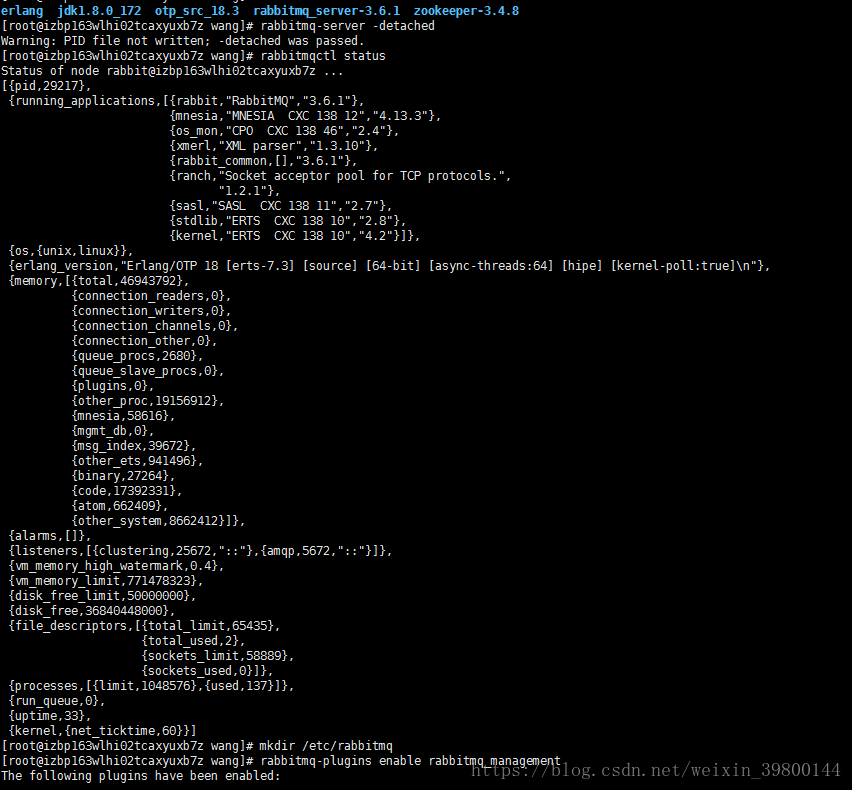centOs install rabbitMQ
Description:
1. The environment is centOS, if it is ubuntu, some commands may be different;
2. My installation directory is under /usr/local/wang, it depends on the situation, don’t copy blindly;
3. When erlang is installed, the screen refresh is very serious, so if you have the correct command, refreshing the screen for tens of seconds or even a minute is no problem.
Just do it!
1. Install dependent files####
yum -y install gcc glibc-devel make ncurses-devel openssl-devel xmlto perl wget
2. Install erlang locale####
wget http://www.erlang.org/download/otp_src_18.3.tar.gz //Download the erlang package
tar -xzvf otp_src_18.3.tar.gz //Unzip.gz package
cd otp_src_18.3///Switch to the installation path./configure --prefix=/usr/local/wang/erlang //Production installation configuration
make && make install //Compile and install the screen is serious, don’t panic
3. Configure erlang environment variables####
vi /etc/profile
//Add the following
# set erlang environment
ERL_HOME=/usr/local/wang/erlang
PATH=$ERL_HOME/bin:$PATH
export ERL_HOME PATH
//Configuration file takes effect
source /etc/profile
Whether the test was successful
erl //If you enter the erlang shell, the installation is successful, just ctrl c to exit.
4. Download and install RabbitMQ
Download and unzip
cd /usr/local/wang///Switch to the directory where RabbitMQ is planned to be installed, I put it here/usr/local/wang/
wget http://www.rabbitmq.com/releases/rabbitmq-server/v3.6.1/rabbitmq-server-generic-unix-3.6.1.tar.xz //Download the RabbitMQ installation package
xz -d rabbitmq-server-generic-unix-3.6.1.tar.xz //Unzip.xz package
tar -xvf rabbitmq-server-generic-unix-3.6.1.tar //Unzip.tar package
5. Configure environment variables
vi /etc/profile
# set rabbitmq environment
export PATH=$PATH:/usr/local/wang/rabbitmq_server-3.6.1/sbin
source /etc/profile
6. Start service
rabbitmq-server -detached //-detached represents the background daemon start.
Check status
rabbitmqctl status
If it is as follows, it is ok

7. Install web plugin####
mkdir /etc/rabbitmq
Start the plugin
rabbitmq-plugins enable rabbitmq_management
8. Configure access account and password
The plug-in requires a username and password by default
rabbitmqctl add_user root root //Add user, the next two parameters are username and password respectively, mine is root
rabbitmqctl set_permissions -p / root ".*"".*"".*"//Add permissions
rabbitmqctl set_user_tags superrd administrator //Modify user role
9. Visit http://ip:15672
(When connecting in the code: the port is 5672), pay attention to open the relevant port

10. User rights####
Here is a supplementary operation command related to permissions
1. User Management#####
(1) Add a user
rabbitmqctl add_user Username Password
(2) Delete a user
rabbitmqctl delete_user Username
(3) Modify the user's password
rabbitmqctl change_password Username Newpassword
(4) View current user list
rabbitmqctl list_users
2. User role
According to personal understanding, user roles can be divided into five categories, super administrators, monitors, policy makers, ordinary managers and others.
(1) Super administrator (administrator)
You can log in to the management console (when the management plugin is enabled), you can view all the information, and you can operate on users and policies.
(2) Monitoring (monitoring)
You can log in to the management console (when the management plugin is enabled), and you can view the relevant information of the rabbitmq node (number of processes, memory usage, disk usage, etc.)
Recommended Posts